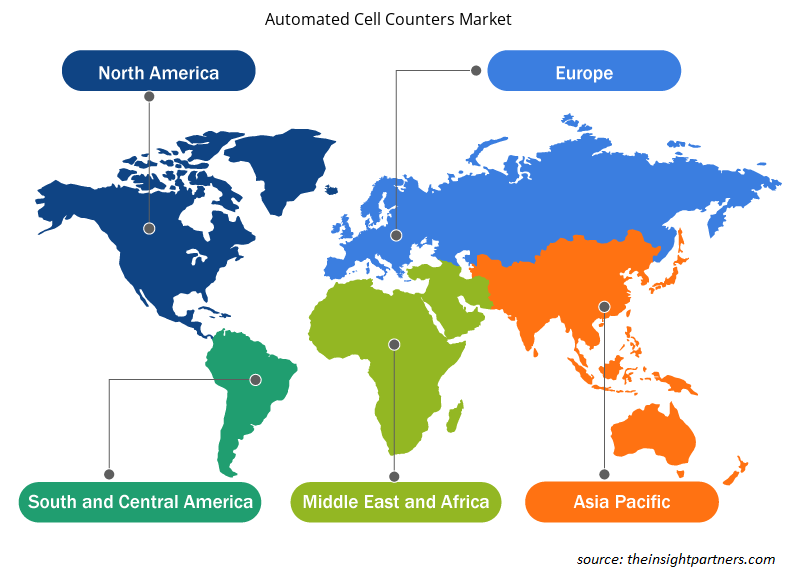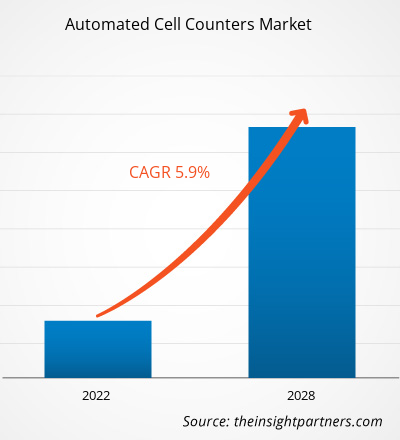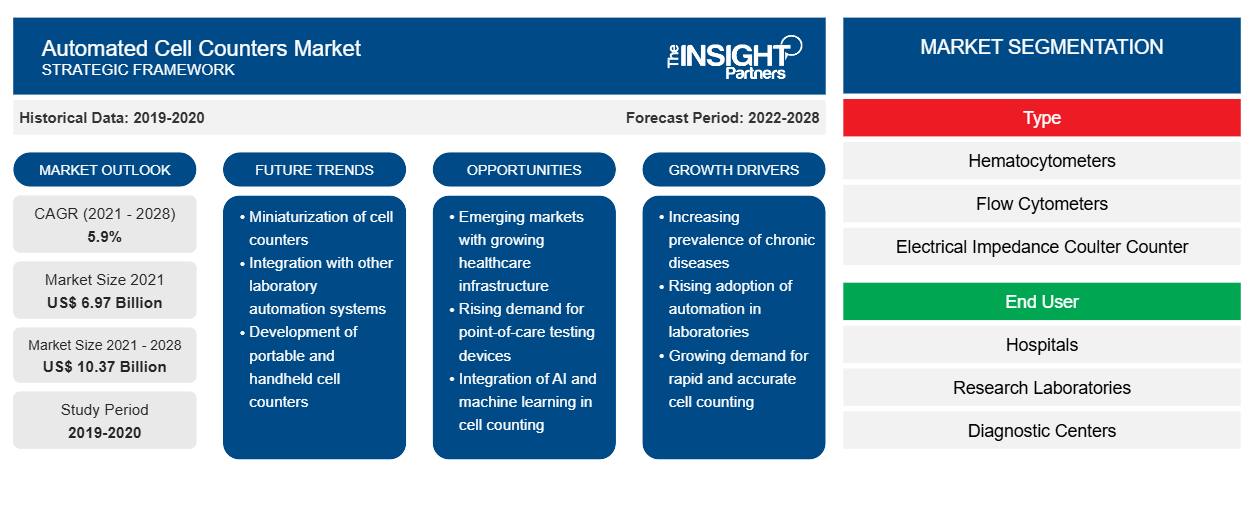자동 세포 카운터 시장은 2021년 69억 7,429만 달러에서 2028년 103억 6,595만 달러로 성장할 것으로 예상되며, 2022년에서 2028년까지 연평균 성장률 5.9%로 성장할 것으로 추산됩니다.
시장 성장은 감염성 질환과 만성 질환의 유병률이 높은 데 기인합니다.
자동 셀 카운터 시장은 제품 출시, 지리적 확장, 기술 발전과 같은 다양한 전략을 채택하는 주요 경쟁 업체로 구성되어 있습니다. 시장의 최근 몇 가지 개발 사항은 다음과 같습니다.
- 2021년 4월, Eppendorf는 실험실 효율성을 높이기 위해 설계된 신제품 "Centrifuge 5910 Ri "의 출시를 발표했습니다. 이 새로운 원심분리기는 인기 있는 Centrifuge 5910 R의 후속 제품이며, 과학자들에게 원심분리 단계를 단순화하고 가속화하는 고급 기능을 제공하는 Eppendorf의 다목적 원심분리기 포트폴리오 의 주력 제품입니다 .
- 2019년 8월, Agilent Technologies, Inc.는 혁신적인 생명 과학 기기의 설계, 제조 및 유통의 선구자인 Biotek Instruments를 인수했다고 발표했습니다. 이 인수로 Agilent의 세포 분석 분야에서의 입지와 전문성이 확대되고, 규모가 크고 성장하는 면역 종양학 및 면역 요법 분야 에서 회사의 입지가 강화됩니다 .
- 2021년 5월, Bio-Rad Laboratories, Inc.는 바코드가 붙은 로드 앤 고 품질 관리 튜브인 InteliQ 제품을 제공함으로써 주요 진단 회사와 파트너십을 맺었다고 발표했습니다 . 예를 들어, Roche와의 파트너십을 통해 고객은 Bio-Rad의 전체 InteliQ 제품 라인과 Unity QC 데이터 관리 솔루션, 고객 교육 및 지원 서비스에 액세스할 수 있습니다.
귀하의 요구 사항에 맞게 이 보고서를 사용자 정의하세요
이 보고서의 일부 또는 국가 수준 분석, Excel 데이터 팩을 포함하여 모든 보고서에 대한 사용자 정의를 무료로 받을 수 있으며 신생 기업 및 대학을 위한 훌륭한 혜택과 할인 혜택을 이용할 수 있습니다.
- 이 보고서의 주요 시장 동향을 알아보세요.이 무료 샘플에는 시장 동향부터 추정 및 예측까지 다양한 데이터 분석이 포함됩니다.
제품 혁신 및 개발에 대한 시장 참여자의 적극적인 참여와 제품 승인 증가는 자동 세포 카운터 시장의 성장을 촉진하고 있습니다. 또한 첨단 기술의 출현으로 시장은 예측 기간 동안 기하급수적으로 성장할 것입니다.
세계보건기구(WHO) 보고서에 따르면, 자동 세포 계수기 장비를 사용하도록 훈련받은 의료 전문가나 근로자가 심각하게 부족합니다. 제약 및 생명공학 분야의 지속적인 연구와 암, 심혈관 질환, HIV/AIDS 등과 같은 질병을 치료하기 위한 다양한 약물의 개발. 자동 세포 계수기의 기술적 발전과 장비의 적용 분야가 증가함에 따라 자동 세포 계수기 사용에 변화가 있었습니다. 자동 세포 계수기의 작동은 어렵고 이 장비에 대한 지식이 엄청나게 중요합니다. 따라서 숙련된 인력에 대한 수요가 있습니다. 이러한 장비에 대한 샘플을 준비하는 것은 지루한 작업이며, 시술 중에 필요한 소모품도 적절하게 관리해야 합니다. 따라서 이러한 장비를 쉽게 사용할 수 있는 숙련된 인력이 부족하여 자동 세포 계수기 시장의 성장이 방해받고 있습니다.
지역 개요
아시아 태평양 지역은 예측 기간 동안 자동 세포 계수기 시장에서 가장 높은 CAGR을 기록했습니다 . 독성학 검사 제품 및 정밀 의약품에 대한 높은 수요, 약물 발견 증가, 주요 시장 참여자의 R&D 투자 증가는 아시아 태평양 자동 세포 계수기 시장 성장을 뒷받침하는 요인 중 일부입니다. 중국의 자동 세포 계수기 시장은 만성 및 감염성 질환 으로 고통받는 인구가 증가함에 따라 확대되고 있습니다 . WHO에 따르면 2018년에 약 125만 명이 HIV에 감염되었으며 이 감염은 젊은층에게 더 흔했습니다. 중국 질병 통제 센터에 따르면 약 400명이 HIV 양성으로 진단되었습니다. 또한 2018년에 중국에서 HIV 및 AIDS 사례가 14% 증가했습니다. HIV 검사는 자동 세포 계수기에 의한 림프구의 절대 계수를 통해 수행됩니다. 따라서 HIV 감염 증가는 자동 세포 계수기 시장 성장을 촉진하고 있습니다.
증가하는 기술 개발과 성장하는 연구 산업은 중국 자동 세포 계수기 시장을 더욱 매력적으로 만듭니다. 예를 들어, 2018년 Sysmex Corporation은 중국 시장에서 자동 혈액 분석기인 XS-500ix를 출시했습니다. 중국의 인구와 경제가 빠르게 성장함에 따라 검사 수요도 증가하고 있습니다. 따라서 중국 정부는 효율성을 높이기 위해 의료 자원을 할당하는 정책을 추진했습니다. 따라서 중국에서 정교하고 고품질의 제품에 대한 수요가 증가하여 자동 세포 계수기 시장 성장이 촉진될 것으로 예상됩니다.Sysmex Corporation launched the XS-500ix, which is an automated Hematology Analyzer in the China market. With the rapidly growing population and economy in China, the demand for tests is also increasing. Therefore, the Chinese government has promoted policies for allocating medical resources to increase efficiency. Thus, this would increase the demand for sophisticated and high-quality products in China, which is expected to boost the market growth of automated cell counters.
인도 가족 및 보건 복지부에서 발표한 2020년 인도 종단 고령화 연구(LASI)에 따르면 인도의 노인 3명 중 2명이 만성 질환을 앓고 있습니다. 나아가 노인 인구의 약 23%가 복합 질환을 앓고 있습니다. CVD는 45세 이상 인구에서 가장 흔한 질병입니다. 45~49세 연령대의 CVD 비율은 19%이고 75세 이상 인구에서는 37%입니다. 2030년까지 비전염성 질환으로 인한 총 질병 부담의 약 45%가 노인 인구 증가로 인해 발생할 것으로 예상됩니다. WHO에 따르면 인도에서는 매년 약 580만 명이 비전염성 질환으로 사망합니다. 따라서 노인 인구의 만성 질환 사례가 증가함에 따라 인도의 자동 세포 계수기 시장이 성장하고 있습니다. 인도 정부는 이러한 질병에 대한 인식을 높이기 위해 암, 당뇨병, 심혈관 질환 및 뇌졸중 예방 및 관리를 위한 국가 프로그램(NPCDS)을 시행하고 있습니다. 여기에는 비전염성 질병을 조기에 발견하기 위한 고혈압, 당뇨병 및 구강암, 유방암 및 자궁경부암 검진이 포함됩니다.Ageing Study in India (LASI) released by the Union Ministry of Family and Health Welfare, 2020, two in three senior citizens in India are suffering from chronic disease. Furthermore, ~23% of the elderly population have multi-morbidities conditions. CVD is the leading disease among the population above 45 years. The CVD percentage in the age group 45–49 years is 19%, and 37% in the population above 75 years. It is expected that ~45% of the total burden of disease due to noncommunicable will be due to the growing elderly population by 2030. According to WHO, ~5.8 million people die from noncommunicable diseases every year in India. Thus, growing chronic disease cases among the elderly population are driving the growth of the automated cell counters market in India. The government of India is implementing the National Programme for Prevention and Control of Cancer, Diabetes, Cardiovascular disease, and Stroke (NPCDS) to create awareness of these diseases. This involves screening for hypertension, diabetes, and oral, breast, and cervical cancers for the early detection of noncommunicable diseases.
따라서 노령 인구 증가, 만성 질환자 수 증가, 질병 관리 조치 등으로 인해 예측 기간 동안 자동 세포 계수기 시장이 활성화될 것으로 예상됩니다.
유형 통찰력
유형에 따라 글로벌 자동 세포 계수기 시장은 혈구계, 유세포계 , 전기 임피던스 콜터 카운터, 분광 광도계로 세분화됩니다. 2021년에 분광 광도계 부문이 시장에서 가장 큰 점유율을 차지했습니다. 콜로니가 나타나기 전에 며칠 동안 배양해야 하는 스팟 플레이트와 달리 분광 광도계 판독값은 즉시 세포 밀도로 변환할 수 있습니다. 분광 광도법은 배양된 세포에 의한 빛 산란을 기반으로 합니다. 분광 광도계의 빛이 세포에 부딪히면 광선이 직선 경로에서 벗어나 이러한 광선이 검출기에 도달하지 못할 수 있습니다. 샘플에 세포 수가 많을수록 더 가벼운 산란이 발생합니다. 질병을 감지하기 위한 조기 진단 절차에 대한 수요가 증가함에 따라 분광기 부문의 성장이 촉진되고 있습니다. 질병 증가와 임상 진단 절차의 성장으로 인해 약물 발견 및 약물 개발 활동이 급증하면서 이 부문의 성장이 촉진되고 있습니다. 약물 발견 및 개발에 대한 정부 주도의 이니셔티브가 늘어나고 생체 분자 분석에 분광기를 적용하는 경우가 늘어나 면서 이 부문의 성장이 촉진되고 있습니다.hemocytometers, cytometerscoulter counters, and spectrophotometers. In 2021, the spectrophotometers segment held the largest share of the market. In contrast to spot plates, which must be incubated for several days before colonies appear, spectrophotometer readings can be instantly converted into cell densities. The spectrophotometric method is based on light scattering by the cells in the culture. When the light in a spectrophotometer hits a cell, light rays are deflected from a straight path, and these light rays may not reach the detector. The greater the number of cells in a sample, the lighter scattering occurs. The growing demand for early diagnostic procedures for the detection of diseases is boosting the growth of the spectrometers segment. A surge in drug discovery and drug development activities due to increasing diseases and growth in clinical diagnostic procedures drive the segment’s growth. An increase in government initiatives in drug discovery & development and a rise in applications of bimolecular analysis is driving the growth of the segment.
혈구 계측기 세그먼트는 예측 기간 동안 가장 높은 CAGR을 기록할 것으로 예상됩니다. 혈구계측기는 원래 혈액 세포를 세기 위해 개발되었습니다. 효모, 원생동물, 박테리아와 같은 단세포 생물을 포함한 모든 유형의 세포를 세는 데 인기를 얻었습니다. 혈구계측기는 세포 계수 에 가장 비용 효율적인 방법입니다 . 혈구계측기는 재사용이 가능하며 광학 현미경과 같은 실험실의 다른 일반적인 도구와 함께 쉽게 사용할 수 있습니다. 빈혈, 지중해 빈혈 , 림프종, 백혈병 및 기타 장애를 유발하는 혈액 세포 장애의 발생률 증가가 세그먼트의 성장을 주도하고 있습니다. 예를 들어, WHO에 따르면 2019년 전 세계 빈혈 유병률은 29.9%로 15~49세 여성 50만 명 이상에 해당합니다. 또한 2019년 전 세계 빈혈 유병률은 6~59개월 아동의 39.8%로 빈혈 아동 2억 6,900만 명에 해당합니다. 혈구 계측기는 개발도상국에서 빈혈을 감지하기 위해 빠르고 효과적인 세포 수를 측정하는 데 사용됩니다. 따라서 다양한 혈액 질환을 감지하기 위한 혈구계측기 의 사용은 2022년부터 2028년까지 이 부문의 성장을 촉진할 것으로 예상됩니다.
자동 세포 계수기 시장에서 활동하는 회사들은 전 세계적으로 변화하는 고객 수요를 충족하기 위해 제품 혁신 전략을 채택하고 있으며, 이를 통해 시장에서 브랜드 이름을 유지할 수 있습니다.
글로벌 자동 셀 카운터 시장 – 세분화
자동 세포 계수기 시장은 유형, 최종 사용자 및 지역으로 세분화됩니다. 유형을 기준으로 시장은 혈구계측기, 유세포계측기, 전기 임피던스 및 분광 광도계로 세분화됩니다. 최종 사용자를 기준으로 시장은 병원, 연구실, 진단 센터 및 기타로 분류됩니다. 지역별로 자동 세포 계수기 시장은 북미(미국, 캐나다 및 멕시코), 유럽(영국, 독일, 프랑스, 이탈리아, 스페인 및 기타 유럽), 아시아 태평양(중국, 일본, 인도, 호주, 한국 및 기타 아시아 태평양), 중동 및 아프리카(UAE, 사우디 아라비아, 아프리카 및 기타 중동 및 아프리카), 남중부 아메리카(브라질, 아르헨티나 및 기타 남중부 아메리카)로 세분화됩니다.
자동 셀 카운터 시장 지역 통찰력
Insight Partners의 분석가들은 예측 기간 동안 자동 세포 계수기 시장에 영향을 미치는 지역적 추세와 요인을 철저히 설명했습니다. 이 섹션에서는 북미, 유럽, 아시아 태평양, 중동 및 아프리카, 남미 및 중미의 자동 세포 계수기 시장 세그먼트와 지리에 대해서도 설명합니다.

- 자동 셀 카운터 시장에 대한 지역별 특정 데이터 얻기
자동 셀 카운터 시장 보고서 범위
| 보고서 속성 | 세부 |
|---|---|
| 2021년 시장 규모 | 69억 7천만 달러 |
| 2028년까지 시장 규모 | 103억 7천만 달러 |
| 글로벌 CAGR (2021-2028) | 5.9% |
| 역사적 데이터 | 2019-2020 |
| 예측 기간 | 2022-2028 |
| 다루는 세그먼트 | 유형별로
|
| 포함된 지역 및 국가 | 북아메리카
|
| 시장 선도 기업 및 주요 회사 프로필 |
|
자동 셀 카운터 시장 참여자 밀도: 비즈니스 역학에 미치는 영향 이해
자동 세포 계수기 시장은 소비자 선호도의 변화, 기술 발전, 제품의 이점에 대한 인식 증가와 같은 요인으로 인해 최종 사용자 수요가 증가함에 따라 빠르게 성장하고 있습니다. 수요가 증가함에 따라 기업은 제품을 확장하고, 소비자의 요구를 충족하기 위해 혁신하고, 새로운 트렌드를 활용하여 시장 성장을 더욱 촉진하고 있습니다.
시장 참여자 밀도는 특정 시장이나 산업 내에서 운영되는 회사나 기업의 분포를 말합니다. 주어진 시장 공간에 얼마나 많은 경쟁자(시장 참여자)가 존재하는지 그 규모나 전체 시장 가치에 비해 나타냅니다.
자동 셀 카운터 시장에서 운영되는 주요 회사는 다음과 같습니다.
- 에펜도르프
- 써모 피셔 사이언티픽 주식회사
- 카운트스타 주식회사
- 바이오라드 연구소 주식회사
- F. 호프만-라 로슈 유한회사
면책 조항 : 위에 나열된 회사는 어떤 특별한 순서에 따라 순위가 매겨지지 않았습니다.

- 자동 셀 카운터 시장 주요 업체 개요를 알아보세요
회사 프로필
- 에펜도르프
- 써모피셔 사이언티픽
- 카운트스타 주식회사
- 바이오라드 연구소 주식회사
- F. 호프만-라 로슈 유한회사
- 케모메텍 A/S
- 정렬유전학
- Beckman Coulter, Inc. (Danaher)
- 나노엔텍
- 올림푸스 주식회사
- 머크 카가아
- 시스멕스 코퍼레이션
- 애질런트 테크놀로지스 주식회사
- 애벗
- 넥셀롬 바이오사이언스 LLC
- 과거 분석(2년), 기준 연도, CAGR을 포함한 예측(7년)
- PEST 및 SWOT 분석
- 시장 규모 가치/거래량 - 글로벌, 지역, 국가
- 산업 및 경쟁 환경
- Excel 데이터세트
최근 보고서
관련 보고서
사용 후기
구매 이유
- 정보에 기반한 의사 결정
- 시장 역학 이해
- 경쟁 분석
- 고객 인사이트
- 시장 예측
- 위험 완화
- 전략 기획
- 투자 타당성 분석
- 신흥 시장 파악
- 마케팅 전략 강화
- 운영 효율성 향상
- 규제 동향에 발맞춰 대응





















 무료 샘플 받기 - 자동 세포 계수기 시장
무료 샘플 받기 - 자동 세포 계수기 시장